
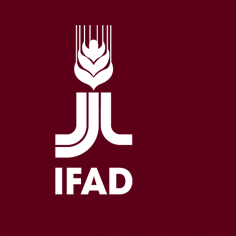
|
Climate change
IFAD projects in Asia and the Pacific consider adaptation and mitigation strategies to address climate change
Climate change is already affecting the implementation of IFAD-supported projects. Snow and glaciers are melting and destroying villages. Drought and floods now occur in unlikely places and at unexpected times. They are having a negative impact on the levels of agricultural production, biodiversity and people. Water scarcity during drought means no water for irrigation, hence reduced crops. Loss of crops results in shortages in food production, which usually translates into greater malnutrition in less favoured areas. Countries propose adaptation and mitigation measures IFAD project representatives discussed measures for adapting to and mitigating the risks of climate change. Their proposals varied depending on their country:
What next? Project representatives expressed the need to improve their understanding of the impact of climate change on poor rural people, especially by listening to poor rural people themselves. Representatives from IFAD-supported regional grant programmes have offered to help identify the challenges and corresponding measures to take, building on work that has already been achieved. To reduce the impact of climate change, IFAD needs to incorporate adequate measures into its project design. For example, the design of new projects could include a component on mitigation. IFAD also needs to identify how it can partner with other projects working on adaptation and mitigation. Together with its stakeholders, it needs to explore the implications of climate change on poverty reduction and options to reduce the related risks more deeply and proactively. The brainstorming session marked the beginning of a process of joint exploration by the ‘IFAD family’. Such exchanges will continue through electronic and face-to-face interactions in preparation for a more focused intervention during the next Annual Performance Review. Martina Spisiakova, Newsletter Coordinator, IFAD Reducing emissions from deforestation in developing countries
On 12 December 2007, the 13th Conference of the Parties (COP) of the United Nations Framework Convention on Climate Change (UNFCCC) affirmed the urgent need to take further action to reduce emissions from deforestation and forest degradation in developing countries. The COP acknowledged the contribution of emissions from deforestation and forest degradation to human-generated greenhouse gas emissions. The parties recognized that the problem is complex and that:
The COP also recognized that the needs of local communities should be addressed when REDD actions are taken. IFAD has provided a grant to the World Agroforestry Centre (ICRAF) to finance a programme for Rewarding the Upland Poor in Asia for the Environmental Services They Provide (RUPES). The programme is helping to build working models of best practices for successful environmental benefit transfer agreements adapted to the Asian context. At the international level in the context of REDD, RUPES and its partners – the Center for International Forest Research (CIFOR) and ICRAF – have actively supported exploring solutions to reduce the massive greenhouse gas emissions from forest conversion and deforestation. The next phase of RUPES programme will test innovative institutional arrangements for international investment under the REDD schemes in reducing the driving forces of deforestation. Forest-based communities will be the main partners in the process. The programme will focus on activities that both reduce greenhouse gas emissions and contribute to local economic development, including helping communities adapt to the negative effects of climate change. For example, it will promote agroforestry systems that store carbon and provide multiple products for local use and markets. Despite increasing concerns about the impact of climate change, the concerns about the rights of local people living on forest lands remain in the background. In particular, such concerns include how much these people will share in REDD benefits, and how robust coordination and interaction will be between national forestry agencies and local government authorities in implementing such an innovative scheme. These issues provide a key opportunity for IFAD to champion the interests of rural poor people in the context of actions and policies on climate change. Dr Meine van Noordwijk, Regional Coordinator, ICRAF (South-east Asia,) and Beria Leimona, RUPES Research Officer, ICRAF SEA and PhD Candidate, the Wageningen University Read more:
IFAD study on the impact of natural disasters and climate change on poor rural people in Asia and the Pacific
The study argues that high temperature, severe drought, flood conditions and soil degradation are likely to cause dramatic declines in agricultural productivity in Asia and the Pacific. As a result, the food security of many developing countries of the region will be under tremendous threat. Because of wide differences in climatological, ecological and socio-economic features in the region, impacts of climate change will vary among sub-regions.
Tropical cyclones and hurricanes are products of complex atmospheric interactions, with a far from straightforward link to global warming. However, global warming has changed environmental conditions in such a way that tropical cyclones are becoming more intense. Recent years were marked by the most costly and destructive cyclones/hurricanes such as Hurricane Katrina in October 2005 and Cyclone Sidr in November 2007. Such events indicate the global trend of increasing frequency and intensity of tropical cyclones since 1995. Moreover, the destructiveness of tropical cyclones has increased worldwide over the last 30 years. The full study will be published by IFAD shortly. Martina Spisiakova, Newsletter Coordinator, IFAD The impact of Cyclone Sidr on IFAD-supported projects
Cyclone Sidr significantly damaged property and infrastructure in an area where two IFAD-supported projects – Microfinance and Technical Support Project (MFTSP) and Market Infrastructure Development Project in Charlands Regions (MIDPCR) – are operating. The cyclone affected about 8.5 million people. As of 2 December 2007, the government’s Disaster Management Information Centre reported that 563,887 houses had been destroyed and 939,675 damaged. A total of at least 500,000 cattle had been killed, which is comparable to the level of losses in the 1991 cyclone. MIDPCR has just started, so the impact of the cyclone on the project was limited. However, MFTSP has been operating for five years and was badly hit. The cyclone affected the groups of 15 out of 24 partner organizations (POs) of the project. Reports from 11 of these 15 POs at the end of November show that 4,174 groups and 44,232 members with current loans amounting to BDT 281.0 million (USD4.1 million) have been affected. This amounts to around 25 to 30 per cent of the total number of participants in the project. Six group members of MFTSP have been reported as being killed, and it would be expected that 20 to 30 people in the families of group members will also have died. A total of 12,223 homes of project group members were totally destroyed, and 21,484 partially destroyed.
Project staff in PKSF are working closely with their colleagues to bring this assistance to the households of affected group members. Discussions with these groups show that they are very receptive to the proposed special loans for housing and re-starting income-generating activities. Many members have withdrawn savings and used them for house repairs, buying food and getting businesses going again.
Edward Mallorie, Microfinance Specialist Read more:
Mainstreaming climate change concerns into strategies and actions in Viet Nam
Importance of rice in Viet Nam In Viet Nam, rice is cultivated on 82 per cent of the arable land and provides 80 per cent of carbohydrate and 40 per cent of protein intake for an average Vietnamese. According to the International Rice Research Institute (IRRI), in 2007 rice production accounted for 43 per cent of the gross revenue of agricultural products. The impact of climate change on rice production
The impact of climate change on rice yields in Viet Nam will depend on changes in temperature in rice-growing regions. IRRI reported that higher maximum temperature can decrease rice yields due to spikelet sterility. Higher minimum temperatures can decrease rice yields due to higher respiration losses. The loss in production can be averted through agricultural research and policies aiming to improve rice varieties and accompanying management strategies. Rice production may also be threatened in those regions that are vulnerable to a rise in sea level. The Fourth Assessment Report of the Intergovernmental Panel on Climate Change (IPCC) estimated that rising sea levels in Viet Nam will range from 10 to 85 cm between 2007 and 2100, posing enormous risks to Viet Nam. Adaptation strategies Considering the increase in frequency of extreme climate events in Viet Nam, the adaptive capacities of small and marginal farming communities are declining. Moreover, farmers with small holdings who depend on rain-fed crops are more vulnerable to extreme climate events. Taking this vulnerability to climatic variation into account, the study suggests the following adaptation activities to enhance the resilience and minimize losses of the farming community and the agricultural sector as a whole:
Mitigation strategies Viet Nam also provides market opportunities for foreign direct investment by implementing Clean Development Mechanism (CDM) projects under the Kyoto Protocol for mitigating climate change. Given the improved institutional framework and expertise to promote CDM activities, Viet Nam could become a key player in the global carbon markets by promoting activities that include:
Role of IFAD The rice fields in the Red River and Mekong River deltas are economically the most important areas in Viet Nam. But they are also highly vulnerable to climate change. The government is trying to address this problem by implementing measures to mitigate the impacts from typhoons, floods and salinization, but such measures need active support by and partnership with donor agencies. Among other recommendations, the study indicated that IFAD could play an important role by targeting its investments in this area in the future and building a long-lasting partnership with the Government of Viet Nam. Bhujang Rao Dharmaji, Senior Climate Change Consultant, Global Mechanism For more information:
Read more:
|
![]()
|
|
[email protected] Martina Spisiakova
Making a Difference in Asia and the Pacific Issue 19: February 2008 Issue 18: December 2007 Issue 17: September-October 2007 Issue 16: June-July 2007 Issue 15: Issue 14: January/February 2007 - Sustainable natural resource management Issue 13: November/December 2006 - PBAS: looking beyond the resource allocation system Issue 12: September/October 2006 - Communication for poverty reduction and rural development Issue 11: July/August 2006 - Working with UN agencies at the country level Issue 10: May/June 2006 - Indigenous peoples and ethnic minorities Issue 9: March/April 2006 - Access to land Issue 8: January/February 2006 - Agricultural Technology Management Issue 7: November/December 2005 - Pro-poor policies Issue 6: September/October 2005 - Gender & MDGs Issue 5: July/August 2005 - Partnership Issue 4: May/June 2005 - Rural Finance Issue 3: March/ April 2005 - Donor Harmonization Issue 2: January/ February 2005 Issue 1: November/ December 2004
Upcoming international events on climate change: The 2008 International Conference on Climate Change, 2-4 March 2008, New York, USA The 4th Annual Brussels Climate Change Conference 2008 – EU Climate Change Policy after Bali, 26-27 February 2008, Brussels, Belgium IPCC Workshop on estimating emissions and removals from land uses, 6-8 May 2008, Helsinki, Finland CCGW 2008: "International Conference on Climate Change and Global Warming", 12-14 September 2008, Heidelberg, Germany 28th Session of the IPCC, 9-10 April 2008, Budapest, Hungary |
![]()
The International Fund for Agricultural Development (IFAD) is a specialized agency of the United Nations, dedicated to eradicating poverty and hunger in developing countries. Its work in remote rural areas of the world helps countries achieve the Millennium Development Goals. Through low-interest loans and grants, IFAD develops and finances projects that enable rural poor people to overcome poverty themselves.
IFAD tackles poverty not just as a lender, but as an advocate for the small farmers, herders, fisherfolk, landless workers, artisans and indigenous peoples who live in rural areas and represent 75 per cent of the world's 1.2 billion extremely poor people. IFAD works with governments, donors, non-governmental organizations, local communities and many other partners to fight the underlying causes of rural poverty. It acts as a catalyst, bringing together partners, resources, knowledge and policies that create the conditions in which rural poor people can increase agricultural productivity, as well as seek out other options for earning income.
IFAD-supported rural development programmes and projects increase rural poor people's access to financial services, markets, technology, land and other natural resources.
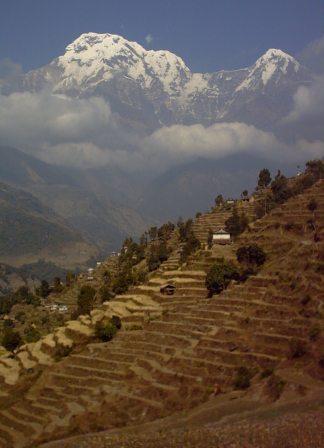 During IFAD’s Annual Performance Review Workshop that took place from 12-15 November 2007 in Bangkok, the Asia and the Pacific Division organized a special session on climate change. This brainstorming event assessed the risks and threats that climate change poses to projects and countries and identified some measures to address them.
During IFAD’s Annual Performance Review Workshop that took place from 12-15 November 2007 in Bangkok, the Asia and the Pacific Division organized a special session on climate change. This brainstorming event assessed the risks and threats that climate change poses to projects and countries and identified some measures to address them.  Globally, loss of tropical forests and peatlands (areas comprised of an accumulation of partially decayed vegetation) contribute approximately 20 per cent of carbon emissions generated by human activity. However, this type of carbon emission has been overlooked when determining global actions to reducing net emissions from the use of land. The Clean Development Mechanism (CDM) of the Kyoto Protocol allows industrialized countries committed to the reduction in
Globally, loss of tropical forests and peatlands (areas comprised of an accumulation of partially decayed vegetation) contribute approximately 20 per cent of carbon emissions generated by human activity. However, this type of carbon emission has been overlooked when determining global actions to reducing net emissions from the use of land. The Clean Development Mechanism (CDM) of the Kyoto Protocol allows industrialized countries committed to the reduction in  Rising temperature, changes in precipitation, floods, droughts and other extreme weather events pose additional risks for already vulnerable communities striving to come out of poverty and achieve sustainable development. In 2006, IFAD undertook various studies to show the links between persistent poverty and the risks emanating from natural hazards, climate change and market volatility. An example is a cross-country analysis titled ‘Natural Disasters, Vulnerability and Mortalities’, conducted by Raghav Gaiha, Professor of Economics, University of Delhi and Ganesh Thapa, Regional Economist, IFAD. The study focuses on the impact of natural disasters and climate change on poor rural people in Asia and the Pacific.
Rising temperature, changes in precipitation, floods, droughts and other extreme weather events pose additional risks for already vulnerable communities striving to come out of poverty and achieve sustainable development. In 2006, IFAD undertook various studies to show the links between persistent poverty and the risks emanating from natural hazards, climate change and market volatility. An example is a cross-country analysis titled ‘Natural Disasters, Vulnerability and Mortalities’, conducted by Raghav Gaiha, Professor of Economics, University of Delhi and Ganesh Thapa, Regional Economist, IFAD. The study focuses on the impact of natural disasters and climate change on poor rural people in Asia and the Pacific. 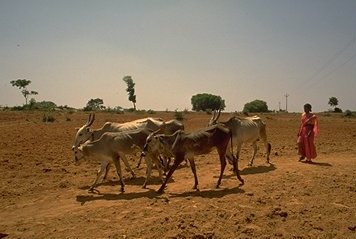 The study also examined different factors influencing the risk of occurrence of natural hazards. It argues that climate change is just one factor influencing this risk. From this perspective, the root cause of increasing risk is the emission of greenhouse gases. Given the sophistication of climate change projections, there is a strong case for factoring information on climate trends. Often the lead time for extreme weather events is sufficiently long for preventive action, provided there is coordination between those disseminating climate information and those responsible for disaster prevention and mitigation. Finally, there are and will be ‘surprises’ as part of generally greater vulnerability. The next disaster may not just be a drought but also a devastating flood.
The study also examined different factors influencing the risk of occurrence of natural hazards. It argues that climate change is just one factor influencing this risk. From this perspective, the root cause of increasing risk is the emission of greenhouse gases. Given the sophistication of climate change projections, there is a strong case for factoring information on climate trends. Often the lead time for extreme weather events is sufficiently long for preventive action, provided there is coordination between those disseminating climate information and those responsible for disaster prevention and mitigation. Finally, there are and will be ‘surprises’ as part of generally greater vulnerability. The next disaster may not just be a drought but also a devastating flood. 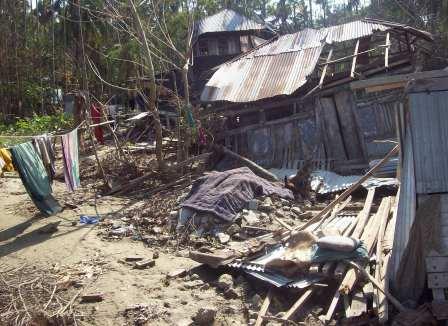 On 15 November 2007, a major cyclone named Sidr hit the southwestern coast of Bangladesh. The storm was the most destructive since the cyclone of April 1991, with similar wind speeds of over 240 km/hour recorded. However, due to improved warning systems and the availability of cyclone shelters for many (but not all) people, the human death toll was around 4,000 compared with over 130,000 in 1991.
On 15 November 2007, a major cyclone named Sidr hit the southwestern coast of Bangladesh. The storm was the most destructive since the cyclone of April 1991, with similar wind speeds of over 240 km/hour recorded. However, due to improved warning systems and the availability of cyclone shelters for many (but not all) people, the human death toll was around 4,000 compared with over 130,000 in 1991. 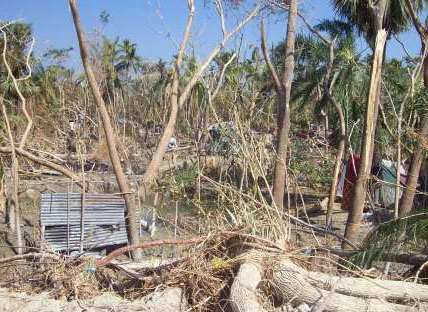 The POs of Palli Karma-Sahayak Foundation (PKSF) were in the forefront of immediate disaster relief, distributing food and water from the stocks of national and international relief agencies as well as using their own resources. PKSF quickly formulated an action plan for cyclone recovery. The plan includes:
The POs of Palli Karma-Sahayak Foundation (PKSF) were in the forefront of immediate disaster relief, distributing food and water from the stocks of national and international relief agencies as well as using their own resources. PKSF quickly formulated an action plan for cyclone recovery. The plan includes:  IFAD and the Global Mechanism – the financing mechanism of the United Nations Convention to Combat Desertification (GM/UNCCD) – are collaborating to articulate the linkages between land degradation and climate change at the community level. As part of the preparation for the Country Strategic Opportunities Programme (COSOP) for Viet Nam, IFAD and the Global Mechanism provided technical expertise and financial support for a joint analysis to identify measures for adaptation to and mitigation of the effects of climate change for IFAD-supported projects.
IFAD and the Global Mechanism – the financing mechanism of the United Nations Convention to Combat Desertification (GM/UNCCD) – are collaborating to articulate the linkages between land degradation and climate change at the community level. As part of the preparation for the Country Strategic Opportunities Programme (COSOP) for Viet Nam, IFAD and the Global Mechanism provided technical expertise and financial support for a joint analysis to identify measures for adaptation to and mitigation of the effects of climate change for IFAD-supported projects.